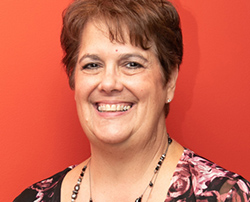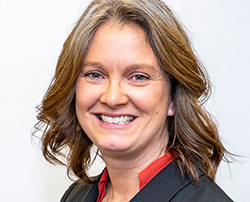YOUNGSTOWN, Ohio – At age 13, Amber King found herself living in group homes and residential care centers. She is one of five biological siblings, but the only one who ended up in care.
King did not get the opportunity to have foster parents or a home life during her teenage years. And living in group home care for so long left her struggling with her mental health.
Through NOAS, formerly Northeast Ohio Adoption Services, King finally got the guidance she needed.
First, NOAS aided her through the Wendy’s Wonderful Kids program. Then after she was emancipated, NOAS continued to support her with the Bridges program.
“They were always my biggest supporters and even to this day I still call them if I need advice,” she says. “I still call them just to check in.”
According to Cheryl Tarantino, executive director of NOAS, the Bridges program helps those ages 18 to 21 emancipating from group homes and foster care to adjust to life as adults. It requires them to either work 20 hours a week or attend a school or job training program, while providing them with a stipend to use for food, housing and clothing. A case manager helps them navigate into adulthood.
How It Helps
King says teenagers in care are not taught many things they need to know for daily living, such as budgeting, how to get utilities turned on, grocery shopping and cooking.
She has reached out to Bridges for assistance filling out financial aid forms for college or for items she couldn’t afford, like a vacuum cleaner.
“I know some people who were in foster care with me, and I always encourage them… ‘Get in Bridges. That is going to be your guide to success,’” King says. “Kids that emancipate, they typically are left to figure it out by themselves. They don’t have the support and the guidance and the help, and they don’t know how to adult.”

Tarantino says 40% of those aging out of foster care have not even graduated high school. They need a GED, and help in continuing to afford their medications, as well as saving money for a car and household supplies. Tarantino adds many literally walk away from their last facility at 18 with a garbage bag containing a few belongings.
“(Bridges) is a great program and when you see the kids utilize it and thrive, it just warms your heart because you know that wouldn’t have been so without it,” Tarantino says.
Unfortunately, Tarantino adds the program is not mandatory and too many are unwilling to fulfill the requirements now that they are 18, and finally able to make their own rules.
More About NOAS
Founded in 1978, NOAS has changed its mission with less of an emphasis on adoption and more on addressing the tremendous need for temporary foster care.
With about 14,700 children in foster care across Ohio and only 7,100 foster homes, Tarantino says siblings end up separated, younger children are ending up in group homes meant for older children and foster children end up on the other side of the state at times or even sleeping in a children services office lobby until a placement can be found.
NOAS supports the efforts of children services by providing additional programs. For instance, the Dave Thomas Foundation provides funding for the Wendy’s Wonderful Kids program, which helps NOAS search for all the people from a child’s previous life beyond parents, aunts and grandparents, who might be willing to connect with the children and support them, even if it is just through letters or phone calls. But ultimately, Tarantino says they are seeking permanency for the child.
NOAS links those helping children to resources through the Ohio Kinship and Adoption Navigator Hotline. NOAS also provides two training programs for foster parents: the Trust Based Relational Intervention and Core Teen. The first is designed to help people connect better with the child and the second is geared toward specific problems facing teenagers. “We always believed that children deserve to grow up in a family and have that permanency,” Tarantino says. “We work with kids every day who are losing hope and then once we find those heroes in our mind, those people who will step up and help care for somebody else’s child, whether it is temporarily or permanently, we want to empower them to feel like they’ve got this. It’s not easy.”
Pilot Program
In May, Gov. Mike DeWine’s office announced $2 million to launch a pilot program to address the statewide shortages in providing more youngsters with foster care instead of group homes.
The Treatment Foster Home Pilot Program will help equip foster parents who are willing and able to take in foster children with significant behavioral health challenges.

It will utilize a regional approach and create new multicounty alliances between public children services agencies. Columbiana, Medina and Portage counties will work together, as will Mahoning, Trumbull and Ashtabula.
Rachel Ketterman, director of the Columbiana County Job and Family Services agency, says the agency is in the early stages in the program, with two adoption assessors now training to certify treatment foster homes into three different tiers of care homes. Then, placements can be matched based on the child’s behavioral history, a current mental health diagnosis and trauma the child was dealing with leading to them being placed in care.
Foster parents taking on the challenge will receive an additional per diem for care.
A regular foster care giver was required to have 24 hours of preplacement training. But for treatment, there could be an additional 30 hours of specialized training on topics that include professional parenting to crisis management. Training time can be reimbursed.
Big Need
Additionally, Ketterman says with the tremendous need, her agency is starting to educate people on what it takes to become a foster parent.
Foster parents for Columbiana County children do not need to live in the county and do not need to be married. They can be two women, two men or even a single person, she adds. What the state does check is financial documents, medical condition and criminal background.
The county has had as many as 150 kids needing foster care since Ketterman became the administrator. The number now stands at around 90. “The kids that we are getting are more difficult at a younger age,” Ketterman says. “They’re experimenting and using drugs. They’re involved in unruly and delinquent behaviors, significant delays, so the things we’re facing are more difficult at a very young age.”
While some children are adopted by their foster parents, that leads to fewer foster parents with experience.
The alternative can be sending them for care in specialized homes or out of state. Columbiana County children services case workers make it a point to visit and check on each child monthly, which can create a burden when they are in another state, Ketterman said.
“That’s the one thing that I’m adamant about and passionate about,” says Ketterman. “We see 100% of our kids. We see our kids. I don’t care where they are placed. I don’t care what it takes.”
She is hoping this treatment training program will help more potential foster parents become willing to step up. Currently there are 13 foster care homes in the county but only three openings.
Without training many are rightfully concerned about taking on a child with emotional problems and behavior issues. This can lead to more children going to group homes at earlier ages.
“It’s sad to have to put 10-year-olds in with 17-year-olds,” Ketterman says. “They grow up real fast.”
King spent her teenage years in group homes, where she says she quickly learned those other teenagers are not your friends. “I was not in a good place. I wasn’t the greatest kid in foster care… I have some crazy stories I could tell,” she says.
Now at age 21, King and her husband, who was adopted himself from foster care at age 9, are in the process of completing the training.
Because they do not have children of their own, King says any children they foster will be cared for without feeling like they are somehow less than their foster parents’ biological children.
“We both know what it’s like to feel like we’re not loved, feel like we’re not wanted, feel like we’re not cared for and just feel like the last option,” King says. “We want to be able to provide kids with coming into a home and feeling like they’re family.”
Pictured at top: Amber King remembers what it was like spending her teenage years in a foster care group home and transitioning into adulthood with help from the Bridges program.
